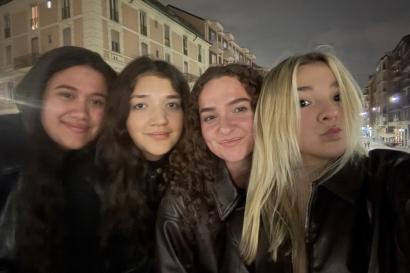Packing for Morocco as a female was initially not an easy task. I scoured the depths of the Internet for travel blogs about what to wear and the common consensus seemed to be to make sure shoulders and knees were covered for all travelers to avoid unwanted attention from men.
Despite the 100° weather, I carefully avoided shorts and tank tops and packed long-sleeved dresses and loose, linen pants. I do find myself needing to wear a scarf or a cardigan under the intense sun rays if I feel exposed compared to the locals. Local women usually wear jeans or business clothes similar to the things we wear in the U.S., perhaps with more of a European flair.

Morocco is a religious country with a primarily Muslim population, and since modesty is encouraged in Islam, it has become a large cultural factor. Many women wear their hair covered or uncovered and then paired with a long djellaba, and also many women dress exactly how we would in the United States – especially in the workplace. The most traditional outfits I see in one place is usually the Old Medina, or the older and more traditional part of the city in which all of the IES Abroad students live.

Women, especially Western women, will receive a lot of male attention no matter how much they cover their bodies. I receive the same amount of comments while wearing a tank top as a full-length dress. The reason that I choose to dress modestly 90% of the time is really just to show the locals that I respect their social norms and I am doing my best to blend. It’s not very difficult to cover up and still feel like your U.S. self: here is a really trendy Instagram user for inspiration.
Tourists are the main targets for harassment because the ability to travel is a privilege and signals wealth. I think it’s okay to embrace being a tourist, for the most part, because maybe you did work really hard for that two-week vacation in Costa Rica, but in order to avoid being scammed, it’s best to try to avoid looking like a tourist with expensive camera bags or bright white tennis shoes – especially here in Morocco.
One of the biggest indicators in Northern Africa of being a tourist is not respecting the modest fashion vibes by wearing tank tops and shorts. While you won’t suffer any serious repercussions, it attracts pesky vendors and overzealous locals. Wearing the loud and colorful ‘elephant’ or bohemian pants, or really anything from the markets that are geared to draw in travelers also screams “temporary visitor.” If I see typically touristy clothing at the markets that I like, I usually just get it as a gift or pack it away to wear in the U.S.

Day to day in the heat, I usually wear jeans or leggings and either a tank top with a cardigan that can be removed while around other Americans or a long-sleeved shirt. I dress up a little bit on the days that I attend class at the university with a more interesting top or a favorite jacket. When attending cultural activities, it’s good to pack a light scarf in case a situation arises where it would be best to cover your hair. Also, locals here (like Europe) never wear sweatpants out in public.


While Moroccan fashion is a pretty diverse blend of many colors and styles, the traditional kaftan is quite unique to the culture. IES Abroad holds a mock wedding every year for the students so that we can don some kaftans lent to us by our host families and enjoy traditional dances. Weddings are a huge affair and are celebrated from early evening until the next morning…sometimes for a couple days at a time! While the kaftans are modest, they are very detailed and can really show off the personality of the person wearing it. Makeup, hair, and henna are also essential parts to complete the look.

Overall, it’s important to wear what makes you feel comfortable in any country, but equally important to be mindful of the culture you have entered. The heat sometimes makes it difficult to wear sleeves and pants, but carrying around a fan or choosing light fabrics make it tolerable. It is also perfectly fine to dress how you want in the private sphere; many girls wear athletic shorts around their host moms or female host siblings. The best way to avoid wearing (or missing wearing) immodest clothing that is usually fine in the U.S. is to just leave it out of the suitcase. I did a lot of shopping beforehand at TJ Maxx, Marshalls, and Old Navy to avoid spending too much money on things I will not wear in the U.S., but after spending a couple months here I deem each of those dollars completely worth the investment so that I feel a little less out of place here.

Morgan Mccullough
<p style="margin-bottom:12.0pt">I am a Michigan native studying Global & International Studies, Arabic, and Spanish. I am a slow traveler and I value getting lost, staying with locals, and learning new languages and traditions. This fall, I am eating my way through the amazing food of the Maghreb and asking a lot of questions about camels, how to barter, and how to say “more tea please?” in Darija<span style="text-autospace:none"><span style="font-size:16.0pt"><span style="font-family:"Times",serif"> </span></span></span></p>








